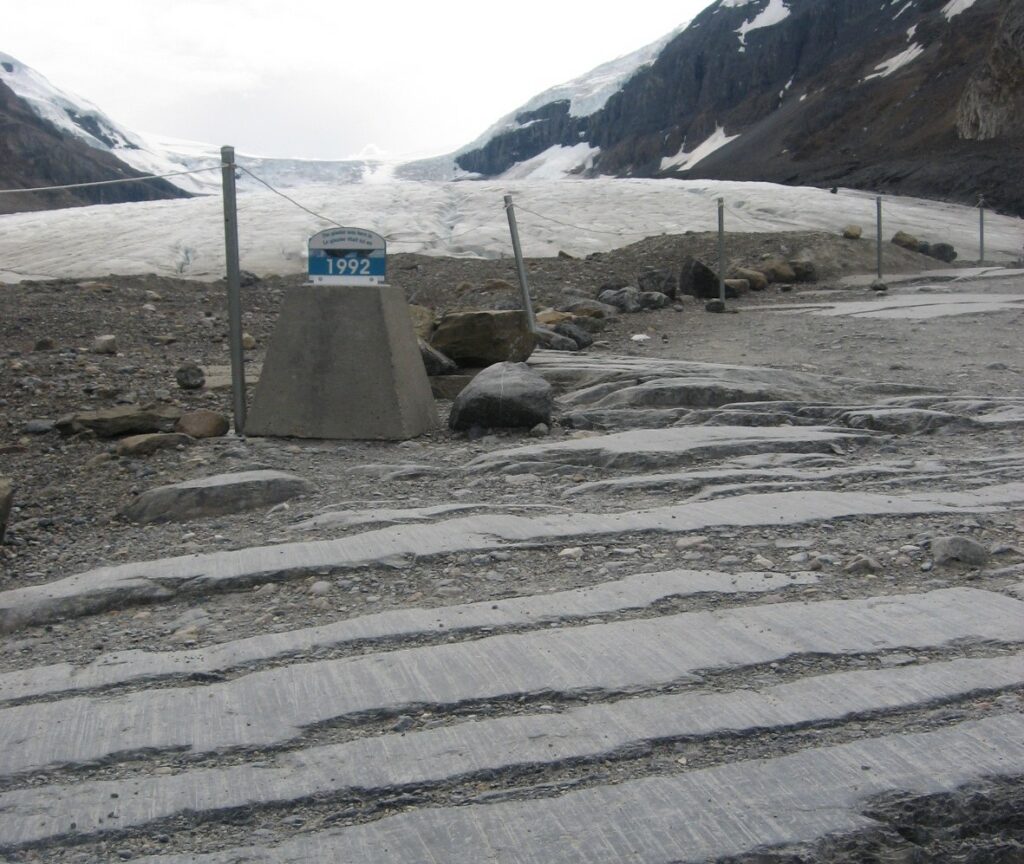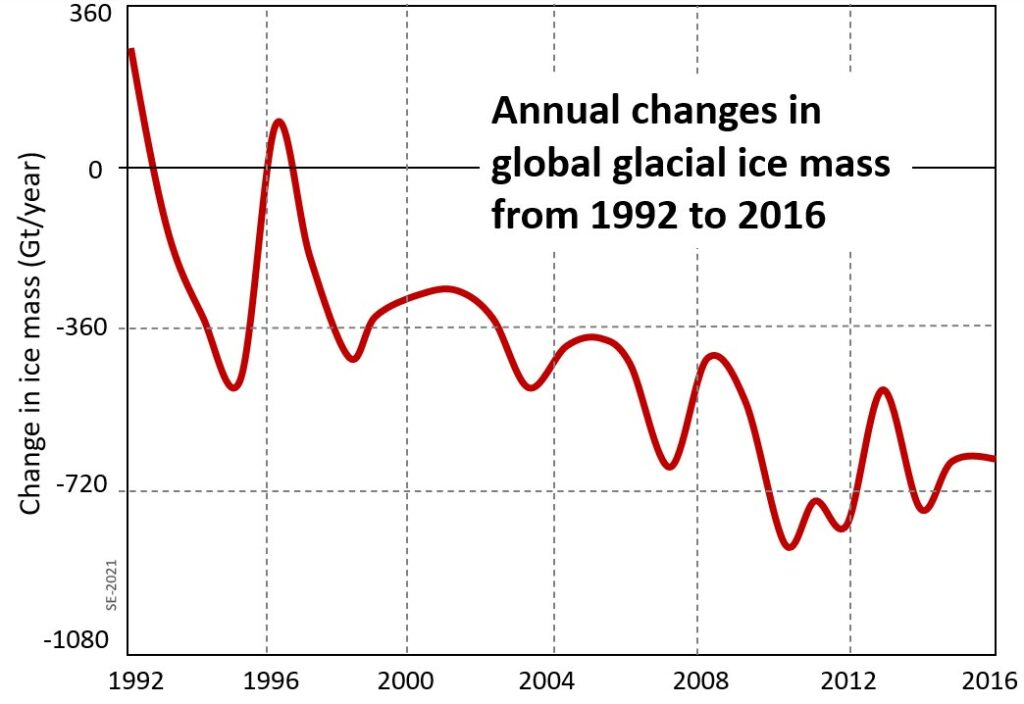4.5 Glaciers and Climate Change, Glaciers and Earth Systems
Glaciers are receding as a result of the warming caused by anthropogenic climate change. A graphic example of this warming can be seen at the Athabasca Glacier, which is receding at a rate of around 5 m per year (Figure 4.5.1).

Most glaciers around the world are receding. Although some are holding steady and just a few are even advancing, the average ice mass balance of glaciers, large and small, is persistently negative. As shown on Figure 4.5.2, the total glacial ice loss (from all of the world’s major ice sheets and alpine glaciers) has been several hundred Gt/y (giga-tonnes per year) for most of the past three decades, and, as the climate has continued to warm, that rate has increased.

Some of the significant environmental and social implications of ice loss on this scale are summarized in a 2019 article by Rasul and Molden.[1] These, and others, can be summarized as follows:
- When glaciers recede, bare rock is exposed, and that has a lower albedo than the glacier did, so heats up more.
- Sea level rise is an obvious consequence of glacial melting and the amount of melting experienced in the past several years contributes approximately 2 mm to sea level rise each year.
- Enhanced melting of glaciers contributes more than normal amounts of fresh water to the oceans. As described in section 3.5, changes to ocean salinity—especially in the north Atlantic—can lead to changes in both surface and deep ocean currents which can have significant climate implications.
- Glacial recession is typically accompanied by melting of permafrost and that results in the release of carbon dioxide and methane, which contribute to more warming. Melting of permafrost also leads to the destabilization of slopes.
- Enhanced glacial melting can enlarge proglacial lakes and that will contribute to the risk of dangerous glacial outburst floods.
- After deglaciation slopes may no longer be supported by ice, and so the risk of slope failure is increased.
- In many regions the supply of drinking and irrigation water is dependent on the slow melting of glacial ice over the summer. As glaciers get smaller, this supply will be less reliable.
- Loss of glacial meltwater will have implications for fish and other aquatic life.
- Glacial regions are important draws for tourists and recreation. The associated economic opportunities will be threatened by glacier loss.
Glaciers and Earth Systems
Glaciers are a special part of the hydrological cycle, and they contribute significantly to Earth systems.
Glaciers, especially large continental ice sheets, contain a massive amount of frozen water, so they exert a strong control over sea level. During periods of extensive glaciation, average sea level can be over 100 m lower than it is now (or significantly more than that at some times in the past). On the other hand, when there is little or no glacial ice sea level would be about 70 m higher than it is now. These variations lead to changes in coastal processes and where those processes take place. For example, coastal regions tend to have low relief and are made of soft sediments following a drop in sea level and tend to have higher relief and are made up of hard rocks when sea level rises. Sea-level changes also change the Earth’s overall albedo, because of changes in the area of reflective ice and non-reflective sea water. Glaciers also have their own albedo effect because of their generally bright surfaces.
Glaciers represent storage of water that would otherwise flow quickly through the hydrological system, so they have significant implications for flow rates at different times of year.
Glaciers also play an important role in shaping mountainous areas into steep slopes, leading to slope failures and enhanced erosion—which reduces the carbon dioxide content of the atmosphere, and they produce a tremendous amount of sediment which has implications for biological processes on land and in the ocean.
Media Attributions
- Figure 4.5.1 Photo by Steven Earle, CC BY 4.0
- Figure 4.5.2 Steven Earle, CC BY 4.0, based on data in: Bamber, J., Westaway, R., Marzeion, B., & Wouters, B. (2018). The land ice contribution to sea level during the satellite era. Environmental Research Letters, 13(6), 063008. https://iopscience.iop.org/article/10.1088/1748-9326/aac2f0/meta
- Rasul, G., & Molden D. (2019). The global social and economic consequences of mountain cryospheric change. Frontiers in Environmental Science, 7(91). https://doi.org/10.3389/fenvs.2019.00091 ↵
